Spatial Differentiation of Carbon Budgets and Carbon Balance Zoning in China Based on the Land Use Perspective
Abstract
1. Introduction
2. Data Sources and Methods
2.1. Data Sources and Preparation
2.2. Method
2.2.1. Land Use Intensity
2.2.2. Land-Use Carbon Budget Accounting
- (1)
- Accounting for total carbon emissions
- (2)
- Accounting for total carbon sinks
2.2.3. Spatial Autocorrelation Model
2.2.4. Economic Contribution Coefficient of Carbon Emissions
2.2.5. Ecological Support Coefficient of Carbon Emissions
3. Results
3.1. Land Use Intensity Analysis
3.2. Analysis of Carbon Source/Sink Land Area by Land Use Type
3.3. Spatial Differentiation Characteristics of Land-Use Carbon Emissions and Carbon Sinks
3.3.1. Analysis of the Spatial Differentiation Characteristics of Land-Use Carbon Emissions
3.3.2. Analysis of the Spatial Differentiation Characteristics of Land-Use Carbon Sinks
3.3.3. Spatial Autocorrelation Analysis
3.4. Carbon Balance Zoning and Low-Carbon Development Proposal
3.4.1. Analysis of the Spatial Characteristics of ECC and ESC
3.4.2. Carbon Balance Zoning
3.4.3. Low-Carbon Development Proposal
4. Discussion
5. Conclusions
- (1)
- The intensity of land use in China is strong, divided by the Heihe–Tengchong Line, showing the characteristic of “high in the southeast and low in the northwest”, with high values concentrated in the Bohai Rim and the eastern coastal region and low values mainly distributed in the Western region.
- (2)
- The spatial heterogeneity of China’s total carbon emissions is apparent, and the emission state is still considered high. Both carbon emission intensity and carbon emissions per capita show the spatial heterogeneity characteristics of “high in the north and low in the south”.
- (3)
- The total carbon sink in China shows the spatial characteristic of “high in the north-south and low in the middle”, which matches the natural resource endowment of China. The overall carbon sink intensity shows a characteristic of continuous decreasing intensity from southeast to northwest.
- (4)
- Total carbon emissions, carbon emission intensity, per capita carbon emissions, total carbon sinks, and carbon sink intensity all have positive global spatial correlations and significant local aggregation effects.
- (5)
- Carbon balance zoning shows a clear aggregation effect. The low-carbon development zone is distributed south of the Qinling Mountains–Huaihe River Line, the carbon sink function zone is mainly distributed in the northwest and northeast, the carbon intensity control zone is mainly distributed in the Yangtze River Delta and Beijing–Tianjin area, and the high-carbon optimization zone is mainly distributed in the Bohai Rim. Development proposals are put forward for both ecological environmental protection and low-carbon economic development.
Author Contributions
Funding
Institutional Review Board Statement
Informed Consent Statement
Data Availability Statement
Conflicts of Interest
References
- Pan, J.H.; Zhang, Y.N. Spatiotemporal patterns of energy carbon footprint and decoupling effect in China. Acta Geogr. Sin. 2021, 76, 206–222. [Google Scholar]
- Wang, S.J.; Xie, Z.H.; Wang, Z.H. The spatiotemporal pattern evolution and influencing factors of CO2 emissions at the county level of China. Acta Geogr. Sin. 2021, 76, 3103–3118. [Google Scholar]
- Wang, G.; Zhang, H.B.; Xue, F.; Zhen, Y. Relations between Land Use Carbon Budget and Economic Development at County Level in Chengdu City. J. Nat. Resour. 2017, 32, 1170–1182. [Google Scholar]
- Houghton, R.A. Revised estimates of the annual net flux of carbon to the atmosphere from changes in land use and land management 1850–2000. Tellus B 2003, 55, 378–390. [Google Scholar]
- Houghton, R.A.; Hackler, J.L. Emissions of carbon from forestry and land-use change in tropical Asia. Glob. Chang. Biol. 1999, 5, 481–492. [Google Scholar] [CrossRef]
- Wang, S.J.; Huang, Y.Y. Spatial spillover effect and driving forces of carbon emission intensity at city level in China. Acta Geogr. Sin. 2019, 74, 1131–1148. [Google Scholar] [CrossRef]
- Shao, S.; Zhang, K.; Dou, J.M. Effects of Economic Agglomeration on Energy Saving and Emission Reduction: Theory and Empirical Evidence from China. Manag. World 2019, 35, 36–60, 226. [Google Scholar]
- Reed, W.P.; Kaye, M.W. Bedrock type drives forest carbon storage and uptake across the mid-Atlantic Appalachian Ridge and Valley, U.S.A. For. Ecol. Manag. 2020, 460, 117881. [Google Scholar] [CrossRef]
- Zhang, X.W.; Li, G.; Dong, K.H.; Zhao, X. Soil Organic Carbon Storage and Vertical Distribution of Main Types Grassland in Shanxi Province. Chin. J. Grassl. 2020, 42, 141–146. [Google Scholar]
- Wu, H.Y.; Meng, Y.; Huang, H.J.; Chen, W.K. Estimation and spatio-temporal divergence of the low-carbon performance of cropland use in China. J. Nat. Resour. 2022, 37, 1148–1163. [Google Scholar] [CrossRef]
- Zhang, M.; Huang, X.J.; Chuai, X.W.; Zhu, Z.Y.; Wang, Y. Urban construction lands and their carbon emission differences east and west of the Hu Huanyong Line. Resour. Sci. 2019, 41, 1262–1273. [Google Scholar]
- Zhou, J.; Wang, Y.X.; Liu, X.R.; Shi, X.C.; Cai, C.M. Spatial Temporal Differences of Carbon Emissions and Carbon Compensation in China Based on Land Use Change. Sci. Geogr. Sin. 2019, 39, 1955–1961. [Google Scholar]
- Wang, C.; Zhan, J.Y.; Zhang, F.; Liu, W.; Twumasi, A.M.J. Analysis of urban carbon balance based on land use dynamics in the Beijing-Tianjin-Hebei region, China. J. Clean. Prod. 2021, 281, 125138. [Google Scholar] [CrossRef]
- Zhang, C.Y.; Zhao, L.; Zhang, H.T.; Chen, M.N.; Fang, R.Y.; Yao, Y.; Zhang, Q.P.; Wang, Q. Spatial-temporal characteristics of carbon emissions from land use change in Yellow River Delta region, China. Ecol. Indic. 2022, 136, 108623. [Google Scholar] [CrossRef]
- Yuan, Y.; Chuai, X.W.; Xiang, C.Z.; Gao, R.Y. Carbon emissions from land use in Jiangsu, China, and analysis of the regional interactions. Environ. Sci. Pollut. Res. 2022, 29, 44523–44539. [Google Scholar] [CrossRef] [PubMed]
- Wang, Z.Y.; Hu, C.G.; Zhang, Y.; Liu, H.L. Characteristics of Carbon Emission Pattern in Hubei Territorial Space and Its Improvement Measures. Planners 2022, 38, 24–31. [Google Scholar]
- Deng, Y.J.; Yao, S.B.; Hou, M.Y.; Zhang, T.Y.; Lu, Y.N. Assessing the effects of the Green for Grain Program on ecosystem carbon storage service by linking the InVEST and FLUS models: A case study of Zichang county in hilly and gully region of Loess Plateau. J. Nat. Resour. 2020, 35, 826–844. [Google Scholar]
- Xia, S.Y.; Yang, Y. Spatio-temporal differentiation of carbon budget and carbon compensation zoning in Beijing-Tianjin-Hebei Urban Agglomeration based on the Plan for Major Function-oriented Zones. Acta. Geogr. Sin. 2022, 77, 679–696. [Google Scholar]
- Zhan, R.Q.; Zhang, S.; Huang, X.J.; Qin, Y.C.; Liu, Y. Spatial variation of carbon budget and carbon balance zoning of Central Plains Economic Region at county-level. Acta Geogr. Sin. 2014, 69, 1425–1437. [Google Scholar]
- Wang, T.F.; Gong, Z.W.; Deng, Y.J. Identification of priority areas for improving quality and efficiency of vegetation carbon sinks in Shaanxi province based on land use change. J. Nat. Resour. 2022, 37, 1214–1232. [Google Scholar] [CrossRef]
- Shan, Y.L.; Liu, J.H.; Liu, Z.; Xu, X.W.H.; Shao, S.; Wang, P.; Guan, D.B. New provincial CO2 emission inventories in China based on apparent energy consumption data and updated emission factors. Appl. Energy. 2016, 184, 742–750. [Google Scholar] [CrossRef]
- China Statistical Yearbook. Available online: https://navi.cnki.net/knavi/yearbooks/YINFN/detail (accessed on 30 August 2022).
- Liu, Z.; Guan, D.B.; Wei, W.; Davis, S.J.; Ciais, P.; Bai, J.; Peng, S.S.; Zhang, Q.; Hubacek, K.; Marland, G.; et al. Reduced carbon emission estimates from fossil fuel combustion and cement production in China. Nature 2015, 524, 335–338. [Google Scholar] [CrossRef] [PubMed]
- Fang, J.Y. Carbon Cycle of Terrestrial Ecosystem in China and Its Global Meaning; China Environmental Science Press: Beijing, China, 1996. [Google Scholar]
- Kuang, Y.Q.; OuYang, T.P.; Zou, Y.; Liu, Y.; Li, C.; Wang, D.H. Present Situation of Carbon Source and Sink and Potential for Increase of Carbon Sink in Guangdong Province. China Popul. Resour. Environ. 2010, 20, 56–61. [Google Scholar]
- Zhang, M.; Lai, L.; Huang, X.J.; Chuai, X.W.; Tan, J.Z. The Carbon Emission Intensity of Land Use Conversion in Different Regions of China. Resour. Sci. 2013, 35, 792–799. [Google Scholar]
- Tsuruta, H.; Mosier, A. Estimate of CH4 Emissions from Year-Round Flooded Rice Fields During Rice Growing Season in China. Pedosphere 2005, 15, 66–71. [Google Scholar]
- Piao, S.L.; Fang, J.Y.; Zhou, L.M.; Zhu, B.; Tan, K.; Tao, S. Changes in vegetation net primary productivity from 1982 to 1999 in China. Glob. Biogeochem. Cycles 2005, 19, GB2027. [Google Scholar] [CrossRef]
- Fang, J.Y.; Guo, Z.D.; Piao, S.L. Terrestrial vegetation carbon sinks in China,1981―2000. Sci. China (Ser. D Earth. Sci.) 2007, 50, 1341–1350. [Google Scholar] [CrossRef]
- Lai, L. Carbon Emission Effect of Land Use in China. Ph.D. Dissertation, Nanjing University, Nanjing, China, 2010. [Google Scholar]
- Ma, J.S.; Liu, X.F.; Zou, T.H. Study on spatial heterogeneity of land use intensity in Nanjing. Sci. Surv. Mapp. 2010, 35, 49–51. [Google Scholar]
- Shi, C.C.; Guo, N.L.; Gao, X.; Wu, F. How carbon emission reduction is going to affect urban resilience. J. Clean. Prod. 2022, 372, 133737. [Google Scholar] [CrossRef]
- Zhao, Y.F.; Han, Z.B.; Xu, Y.Q. Impact of Land Use/Cover Change on Ecosystem Service Value in Guangxi. Sustainability 2022, 14, 10867. [Google Scholar] [CrossRef]
- Xu, Y.; Guo, N.; Ru, K.L.; Fan, S.L. Characteristics and optimization strategies of territorial space zone in Fujian Province, China based on carbon neutrality. Chin. J. Appl. Ecol. 2022, 33, 500–508. [Google Scholar]
- Chen, W.X.; Zeng, J. Decoupling analysis of land use intensity and ecosystem services intensity in China. J. Nat. Resour. 2021, 36, 2853–2864. [Google Scholar] [CrossRef]
- Li, J.S.; Guo, X.M.; Chuai, X.W.; Xie, F.J.; Yang, F. Reexamine China’s terrestrial ecosystem carbon balance under land use-type and climate change. Land Use Policy 2021, 102, 105275. [Google Scholar] [CrossRef]
- Tang, X.L.; Lu, C.Y.; Meng, P.; Cheng, W. Spatiotemporal Evolution of the Environmental Adaptability Efficiency of the Agricultural System in China. Sustainability 2022, 14, 3685. [Google Scholar] [CrossRef]
- Zhu, M.C.; Shen, L.Y.; Tam, V.W.Y.; Liu, Z.; Shu, T.H.; Luo, W.Z. A load-carrier perspective examination on the change of ecological environment carrying capacity during urbanization process in China. Sci. Total Environ. 2020, 714, 136843. [Google Scholar] [CrossRef] [PubMed]
- Xu, W.H.; Xie, Y.L.; Ji, L.; Cai, Y.P.; Yang, Z.F.; Xia, D.H. Spatial-temporal evolution and driving forces of provincial carbon footprints in China: An integrated EE-MRIO and WA-SDA approach. Ecol. Eng. 2022, 176, 106543. [Google Scholar] [CrossRef]
- Lin, Q.W.; Zhang, L.; Qiu, B.K.; Zhao, Y.; Wei, C. Spatiotemporal Analysis of Land Use Patterns on Carbon Emissions in China. Land 2021, 10, 141. [Google Scholar] [CrossRef]
- Jing, X.D.; Tian, G.L.; Li, M.R.; Javeed, S.A. Research on the Spatial and Temporal Differences of China’s Provincial Carbon Emissions and Ecological Compensation Based on Land Carbon Budget Accounting. Int. J. Environ. Res. Public Health 2021, 18, 12892. [Google Scholar] [CrossRef]
- Huang, H.Q.; Zhou, J. Study on the Spatial and Temporal Differentiation Pattern of Carbon Emission and Carbon Compensation in China’s Provincial Areas. Sustainability 2022, 14, 7627. [Google Scholar] [CrossRef]
- Yang, M.; Liu, Y.S.; Tian, J.Z.; Cheng, F.Y.; Song, P.B. Dynamic Evolution and Regional Disparity in Carbon Emission Intensity in China. Sustainability 2022, 14, 4052. [Google Scholar] [CrossRef]
- Wang, Y.L.; Wang, X.H.; Wang, K.; Chevallier, F.; Zhu, D.; Lian, J.H.; He, Y.; Tian, H.Q.; Li, J.S.; Zhu, J.X.; et al. The size of the land carbon sink in China. Nature 2022, 603, E7–E9. [Google Scholar] [CrossRef]
- Wang, J.; Feng, L.; Palmer, P.I.; Liu, Y.; Fang, S.X.; Bösch, H.; O’Dell, C.W.; Tang, X.P.; Yang, D.G.; Liu, L.X.; et al. Large Chinese land carbon sink estimated from atmospheric carbon dioxide data. Nature 2020, 586, 720–723. [Google Scholar] [CrossRef] [PubMed]
- Chen, J.D.; Li, Z.W.; Song, M.L.; Dong, Y.Z. Decomposing the global carbon balance pressure index: Evidence from 77 countries. Environ. Sci. Pollut. Res. Int. 2020, 28, 7016–7031. [Google Scholar] [CrossRef] [PubMed]
- Chuai, X.W.; Huang, X.J.; Lu, Q.L.; Zhang, M.; Zhao, R.Q.; Lu, J.Y. Spatiotemporal Changes of Built-Up Land Expansion and Carbon Emissions Caused by the Chinese Construction Industry. Environ. Sci. Technol. 2015, 49, 13021–13030. [Google Scholar] [CrossRef] [PubMed]
- Xia, F.; Yang, Y.X.; Zhang, S.Q.; Li, D.H.; Sun, W.; Xie, Y.J. Influencing factors of the supply-demand relationships of carbon sequestration and grain provision in China: Does land use matter the most? Sci. Total Environ. 2022, 832, 154979. [Google Scholar] [CrossRef] [PubMed]
- Li, L.; Hong, X.F.; Peng, K. A spatial panel analysis of carbon emissions, economic growth and high-technology industry in China. Struct. Chang. Econ. Dyn. 2019, 49, 83–92. [Google Scholar] [CrossRef]
- Fang, J.Y.; Guo, Z.D.; Hu, H.F.; Kato, T.; Muraoka, H.; Son, Y. Forest biomass carbon sinks in East Asia, with special reference to the relative contributions of forest expansion and forest growth. Glob. Chang. Biol. 2014, 20, 2019–2030. [Google Scholar] [CrossRef]
- Jonsson, M.; Bengtsson, J.; Gamfeldt, L.; Moen, J.; Snäll, T. Levels of forest ecosystem services depend on specific mixtures of commercial tree species. Nat. Plants 2019, 5, 141–147. [Google Scholar] [CrossRef]
- Huang, L.; Liu, J.Y.; Shao, Q.Q.; Xu, X.L. Carbon sequestration by forestation across China: Past, present, and future. Renew. Sustain. Energy Rev. 2011, 16, 1291–1299. [Google Scholar] [CrossRef]
- Han, X.Y.; Cao, T.Y.; Sun, T. Analysis on the variation rule and influencing factors of energy consumption carbon emission intensity in China’s urbanization construction. J. Clean. Prod. 2019, 238, 117958. [Google Scholar] [CrossRef]
- Chuai, X.W.; Huang, X.J.; Qi, X.X.; Li, J.S.; Zuo, T.H.; Lu, Q.L.; Li, J.B.; Wu, C.Y.; Zhao, R.Q. A Preliminary Study of the Carbon Emissions Reduction Effects of Land Use Control. Sci. Rep. 2016, 6, 36901. [Google Scholar] [CrossRef] [PubMed]

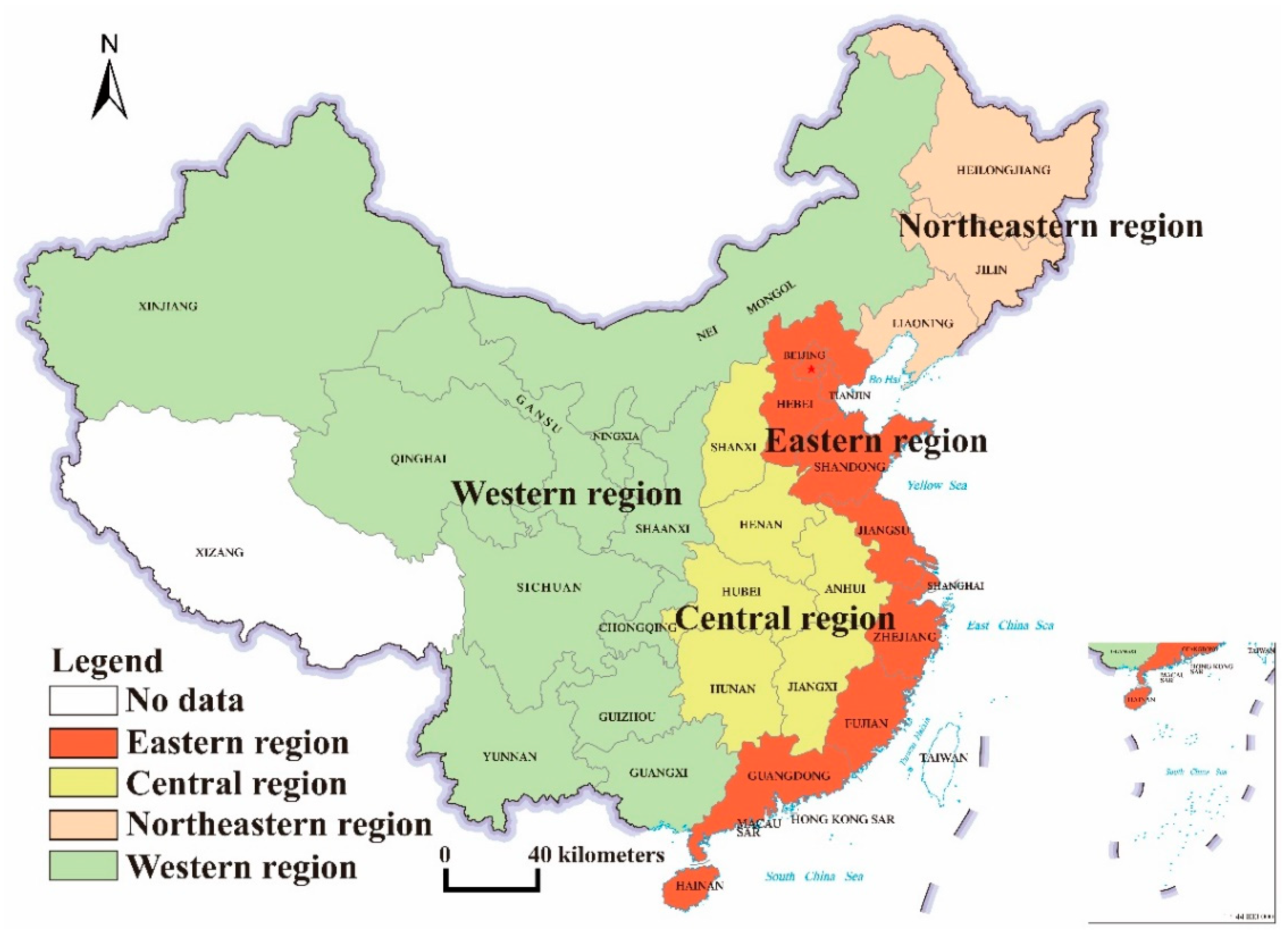

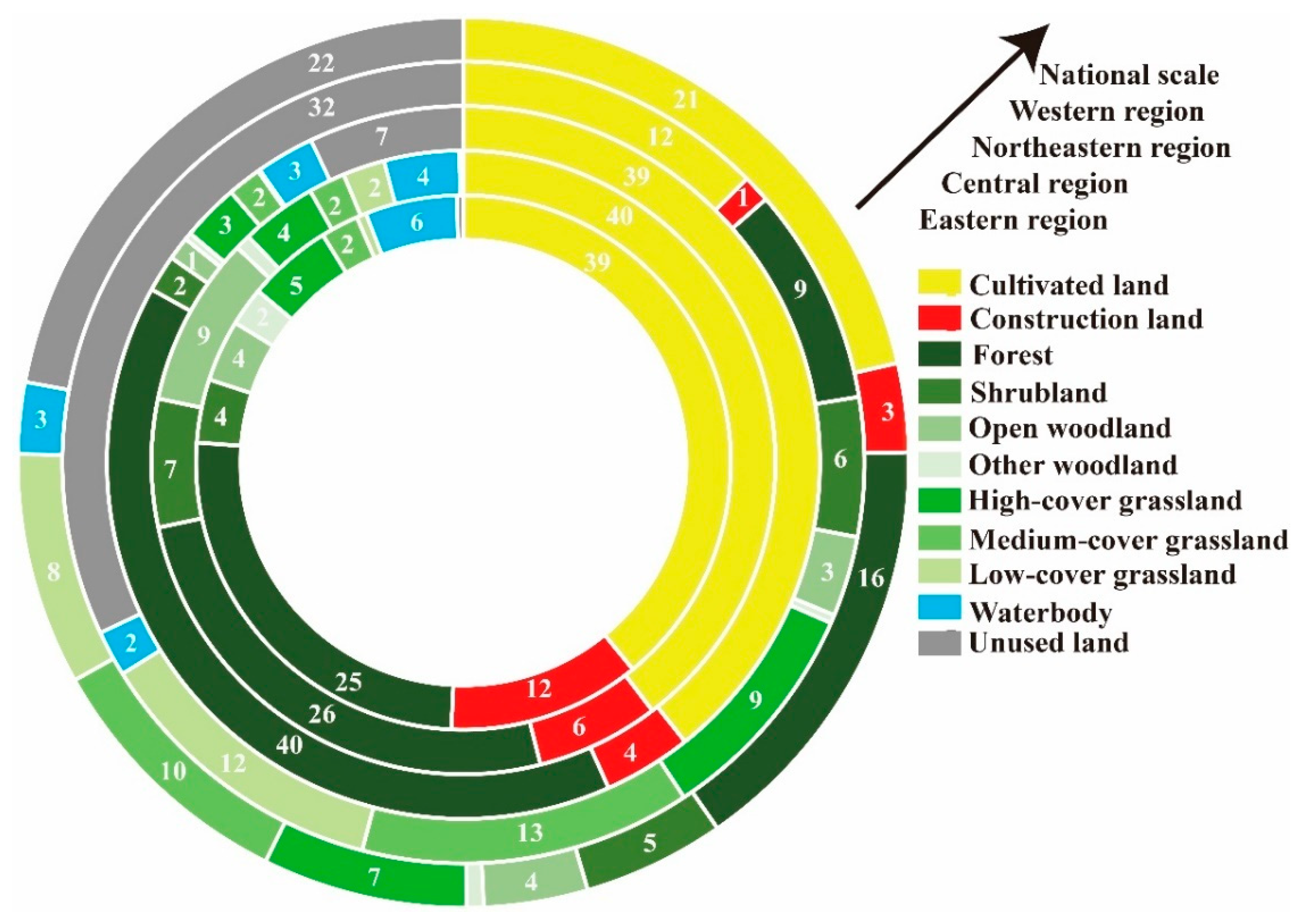
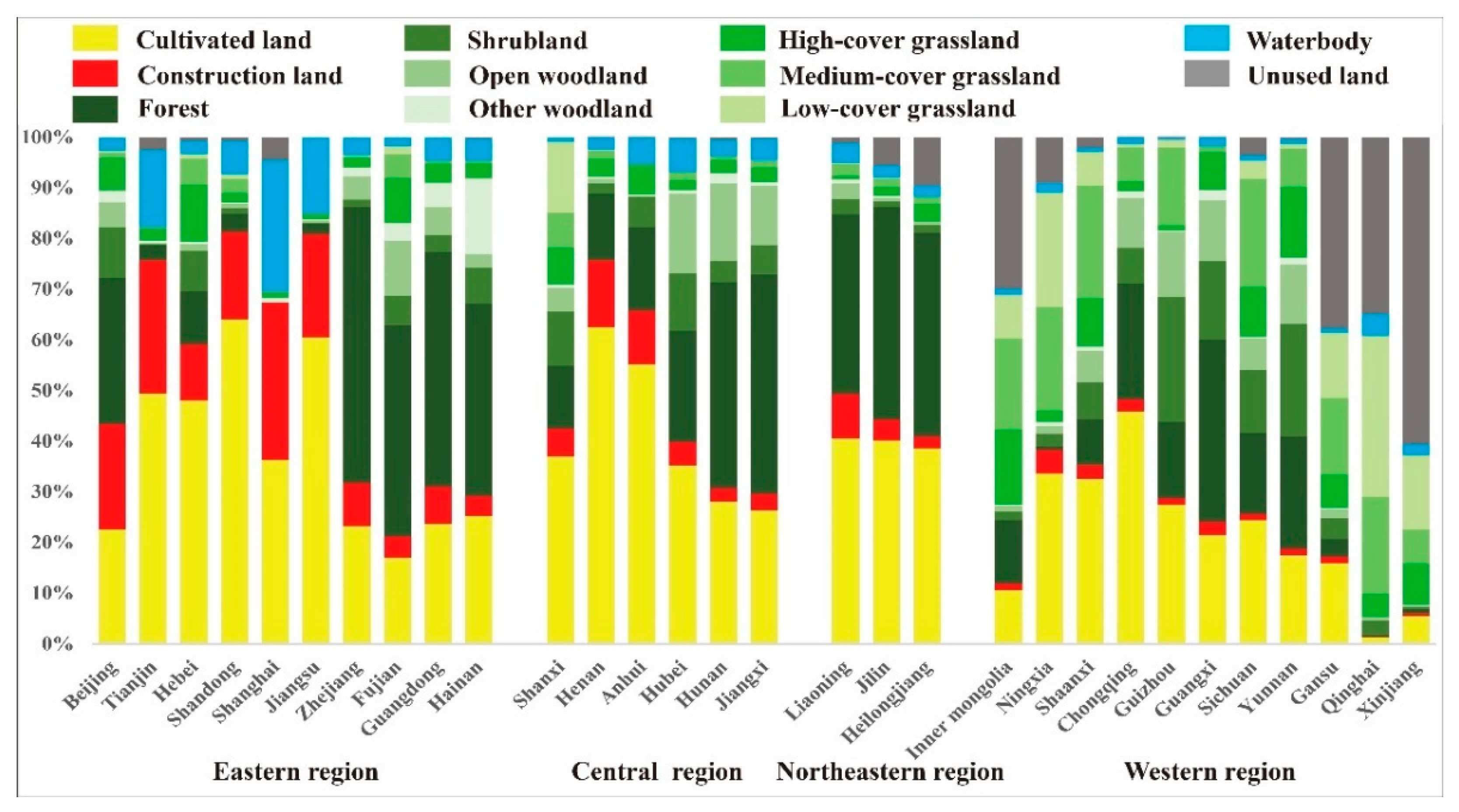

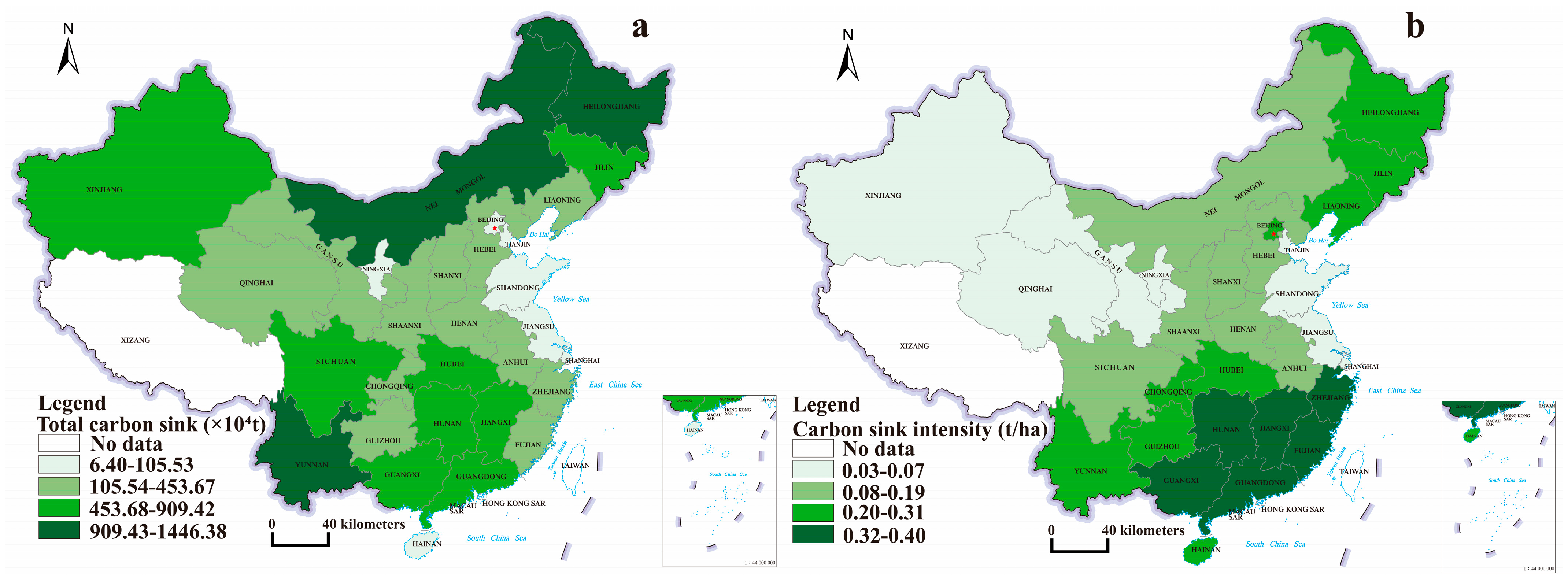


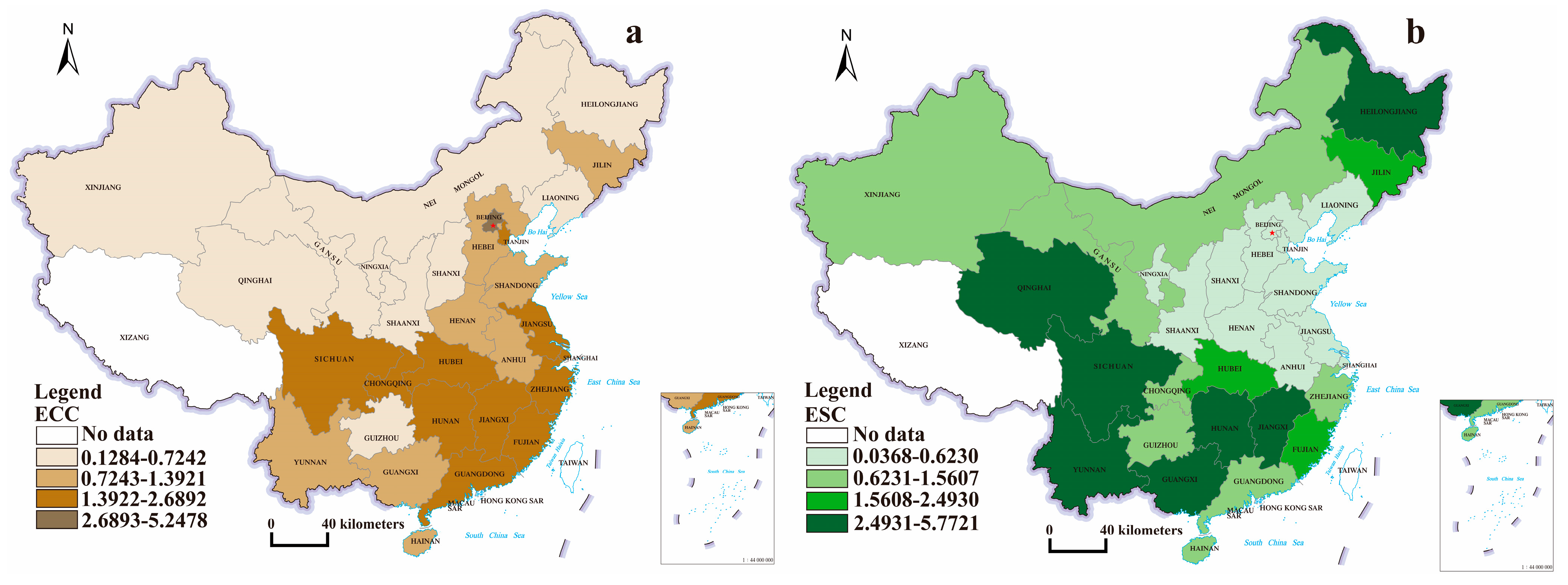
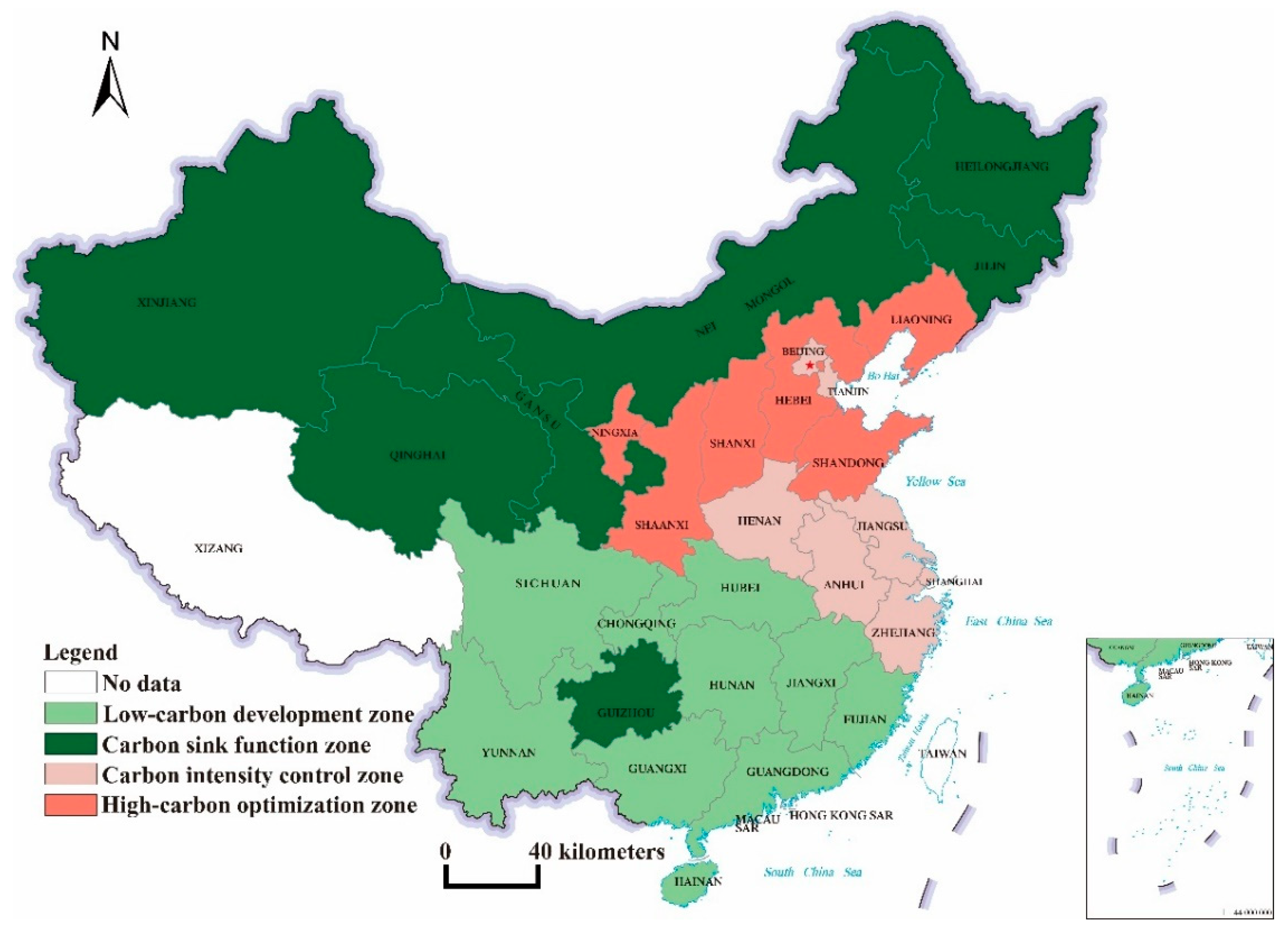
| Notation | Carbon Emission Component | Coefficient | Units | Source |
|---|---|---|---|---|
| Raw coal | 0.499 | Liu et al. [23] | ||
| Crude oil | 0.838 | Liu et al. [23] | ||
| Natural gas | 0.590 | Liu et al. [23] | ||
| Human respiration | 0.079 | Fang [24] | ||
| Pig | 0.082 | Kuang [25] | ||
| Cattle | 0.769 | Kuang [25] | ||
| Cultivated land | 0.374 | Zhang et al. [26], Tsuruta et al. [27] | ||
| Forest | −0.657 | Fang [24] | ||
| Shrubland | −0.161 | Piao et al. [28] | ||
| Open woodland | −0.581 | Fang [24] | ||
| Other woodland | −0.103 | Piao et al. [28] | ||
| High-cover grassland | −0.138 | Piao et al. [28] | ||
| Medium-cover grassland | −0.046 | Piao et al. [28] | ||
| Low-cover grassland | −0.021 | Fang et al. [29] | ||
| Unused land | −0.005 | Lai [30] | ||
| Waterbody | −0.253 | Lai [30] |
| Zone Name | Conditions | Province |
|---|---|---|
| Low-carbon development zone | ECC >1 & ESC >1 | Sichuan, Chongqing, Hubei, Hunan, Jiangxi, Fujian, Guangdong, Guangxi, Yunnan, Hainan |
| Carbon sink function zone | ECC < 1 & ESC > 1 | Xinjiang, Gansu, Qinghai, Inner Mongolia, Jilin, Heilongjiang, Guizhou |
| Carbon intensity control zone | ECC > 1 & ESC < 1 | Beijing, Tianjin, Henan, Anhui, Jiangsu, Shanghai, Zhejiang |
| High-carbon optimization zone | ECC < 1 & ESC < 1 | Ningxia, Shaanxi, Shanxi, Hebei, Shandong, Liaoning |
Publisher’s Note: MDPI stays neutral with regard to jurisdictional claims in published maps and institutional affiliations. |
© 2022 by the authors. Licensee MDPI, Basel, Switzerland. This article is an open access article distributed under the terms and conditions of the Creative Commons Attribution (CC BY) license (https://creativecommons.org/licenses/by/4.0/).
Share and Cite
Wen, H.; Li, Y.; Li, Z.; Cai, X.; Wang, F. Spatial Differentiation of Carbon Budgets and Carbon Balance Zoning in China Based on the Land Use Perspective. Sustainability 2022, 14, 12962. https://doi.org/10.3390/su142012962
Wen H, Li Y, Li Z, Cai X, Wang F. Spatial Differentiation of Carbon Budgets and Carbon Balance Zoning in China Based on the Land Use Perspective. Sustainability. 2022; 14(20):12962. https://doi.org/10.3390/su142012962
Chicago/Turabian StyleWen, Hui, Yi Li, Zirong Li, Xiaoxue Cai, and Fengxia Wang. 2022. "Spatial Differentiation of Carbon Budgets and Carbon Balance Zoning in China Based on the Land Use Perspective" Sustainability 14, no. 20: 12962. https://doi.org/10.3390/su142012962
APA StyleWen, H., Li, Y., Li, Z., Cai, X., & Wang, F. (2022). Spatial Differentiation of Carbon Budgets and Carbon Balance Zoning in China Based on the Land Use Perspective. Sustainability, 14(20), 12962. https://doi.org/10.3390/su142012962






